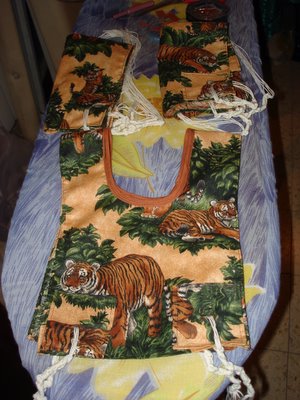Tiger Tzitzit
Tzitzit, the ritual fringes attached to the corners of a four-cornered garment, are worn by religious Jews beginning at three years of age. (The sources of the commandment to wear tzitzit are Numbers 15:38 and Deuteronomy 22:12.) In the past, tzitzit were worn mostly by men, though we know of a number of women who wore them at various times during Jewish history. These women were usually the relatives of recognized religious leaders and sometimes functioned as religious leaders themselves. (One exception to this general rule was Hannah Rachel Werbermacher, the Maiden of Ludomir [c. 1815–1892], who wore tzitzit and tefillin [phylacteries] and functioned as a hassidic rebbe even though she was not related to a prominent religious leader.)
A major reason that so few Jewish women wore tzitzit until recently is that Jewish law exempts women from observing most commandments that must be performed at a specific time. Since the commandment to wear tzitzit falls into this category—they must be worn during the day—women are considered exempt from the duty to wear them. However, women may wear tzitzit if they wish, and now that high-level Jewish learning is open to women as it never was before, more and more religiously observant women are deciding to wear them as an expression of their commitment, and more and more young girls have begun to do so as well.
(I think it is fair to mention here that some streams within Orthodox Judaism still maintain that exemption equals prohibition where women are concerned, and oppose the idea of women wearing tzitzit or performing religious acts that for many generations were considered the exclusive province of men.)
Women who want to wear tzitzit have something else to consider. According to Jewish law, men may not wear clothing intended for women and vice versa (Deuteronomy 22:5). Therefore, some contemporary religious authorities state that if a woman or girl wishes to wear tzitzit, the garment to which they are attached should not resemble the style currently being used by men. (This, incidentally, was the suggestion made by Rabbi Yehuda Herzl Henkin to my women’s prayer group, Shirat Sara: that a woman who wishes to wear a tallit [prayer shawl] during our services should wear one that appears “distinct from the current style of men’s tallitot.”)
So where is all this background information leading? To this: when a friend of mine asked me to sew tzitzit for her small daughter some time ago, I happily obliged. Her daughter chose some material from a fabric store, I got out the sewing machine, and this is what resulted:
Tiger tzitzit. I like the sound of that.
(And yes, the fact that the fabric featured felines made the job all that much more fun.)
UPDATE: If you have come here from another site, please see this post.

Beautiful! Do you have instructions on how to sew the edges (square patches)or a pattern in general...for women and girls???
ReplyDeleteTodarobah!
Chana
Chana, thank you!
ReplyDeleteI don't have a pattern -- I modeled these sets on an existing set that my friend gave me, so that the size would be correct.
As for the square patches: I cut them out of the fabric, making allowance for turning over the edges, sew the edges down, then sew the squares to the garment and make a buttonhole in the middle. That's it.